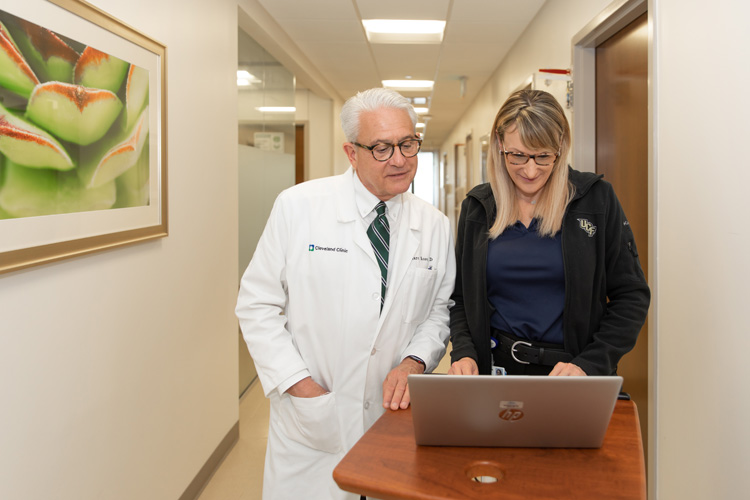
Cleveland Clinic Indian River Hospital urologist Dr. Marc Rose just had an ‘up-close-and-personal’ experience with MOSES.
Or, more specifically, the MOSES holmium lithotripsy laser: a new, high-tech tool for safely and quickly removing painful kidney stones. In this case, it was used to remove Rose’s own kidney stone.
According to the Urology Care Foundation, “more than 1 million Americans will get a kidney stone this year alone [and] the number of people in the U.S. getting stones is rising.” Statistically, Rose is just one more such patient.
Kidney stones, according to the Mayo Clinic, “form when your urine contains more crystal-forming substances – such as calcium, oxalate and uric acid – than the fluid in your urine can dilute. At the same time, your urine may lack substances that prevent crystals from sticking together, creating an ideal environment for kidney stones to form.”
And form they did in Rose.
“Yes,” Rose deadpans, “I recently had my first kidney stone and I enjoyed every minute of it, of course,” though he quickly adds, with a wry smile, “my wife said I very crabby, which I find impossible to believe.”
In the 1980s about 3 in every 100 people got a kidney stone sometime in their life, but by 2010 that number had tripled to 9 in every 100 and has only continued to increase over the past decade.
If you’re the sort who wants to ‘follow the money,’ rather than the numbers, the 2 million healthcare provider visits and over 600,000 ER visits related to kidney stones – as well as the lost time from work because of those stones – now costs the U.S. economy more than $5.3 billion each year.
But how, exactly, did a Biblical icon like “MOSES” get associated with kidney stones?
“In urology,” Rose explains, “using lasers for stones has been going on since about 30 years ago, but the lasers that were originally used were not very good. They didn’t work very well or accomplish what you wanted, but as time has gone on [new laser technology] has gotten better and better.
“What’s great about the [new] MOSES laser,” Rose says, is that unlike earlier lasers, the energy pulse doesn’t, “push the stone away” forcing the operator to “chase it” through the ureter tube; a spaghetti-thin passageway in which many stones get caught or stuck.
The reason it is called this MOSES, according to Rose, is a reference to the Biblical story of the parting the Red Sea.
This laser has two pulses. The first one pushes the irrigation fluid or saline and urine in front of the stone away, allowing the second pulse to hit and break up the stone into minute pieces that can then be collected with a tiny scoop. Often it breaks the stone into such small pieces that they can pass through the system on their own without causing any pain.
Equally to the point, Rose continues, “it’s much more efficient and the operating time and the time under anesthesia goes down significantly. And, what we’re really happy about, is that we are one of the very few hospitals in Florida” to have this laser.
That, according to Rose, is especially important in that “Florida, Georgia and the deep south are considered the kidney stone belt. There seem to be more stones in this area and the reason is probably the heat and that people don’t drink enough water. The No. 1 reason people get stones is they’re not hydrating adequately.”
Pausing briefly, the now-kidney-stone-free Rose, a dyed-in-the-wool Ohio State Buckeye fan, gives credit for the acquisition of this MOSES laser to Cleveland Clinic Indian River Hospital OR Director Patty Lees and Chief Operating Officer Ralph Turner.
It was, says Rose, “a team effort” to bring this advanced technology to Vero Beach.
He also singles out fellow urologist, Dr. R. Carrington Mason, who performed the MOSES procedure.
And, despite Rose’s vast experience, he says he learned something from his personal experience with kidney stones: “I thought I was sympathetic to my patients who had stones before. Now I know I really am.”
The National Institutes of Health says the MOSES technology has been shown to decrease the procedure time for kidney stone removal by about 35 percent when compared to older lasers and that, along with a comparably lower need for anesthesia, lowers the cost while delivering superior results.
In fact, Urology Today calls these new MOSES lasers today’s “gold standard” for removing kidney stones.
Dr. Marc Rose is a urologist with the Cleveland Clinic Indian River Hospital. His office is at 3450 11th Court, Suite 303 in Vero Beach. The phone number is 772-567-3003. Dr. Rose has been named one of Indian River County’s Top Doctors by Castle Connolly Medical Ltd.



